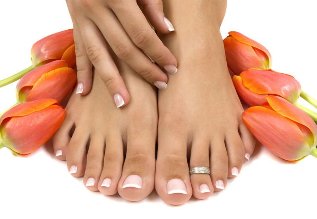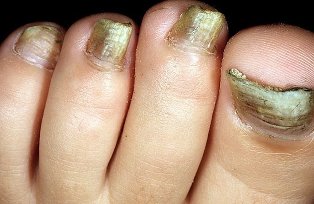Many do not even suspect that a commonplace sweating of the feet accompanied by an unpleasant odor, that suffer more than half of the population of our planet, one of the main symptoms of nail fungus. This disease takes the risk of falling ill to all those who already have a little careless in their personal hygiene. Nail fungus lurks everywhere, especially in public places. And the most terrible is that the nail fungus quite insidious of the disease: its treatment is of long duration, and is not always successful, so that athlete's foot is prone to relapse. To recognize the disease and treatment, it is necessary to know all the symptoms of mycosis of the feet.

How to spread the disease?
The infection causing fungi. The ideal environment for their reproduction and development, the moisture combined with a warm atmosphere. It is considered that the main places where a high risk of being infected by nail fungus, this steam rooms, saunas, water parks, swimming pools, nail salon, etc, However, the statistics completely denies these allegations: nail fungus, you can remove from the home through the common things (sheets, shoes, clothes, carpet, shower stall or bathroom), if someone of the members of the family have this problem, or outside, for example, through slippers, kindly offered by the master (and he may not even suspect the presence in him of the disease).
But what are the factors that influence the development of fungal disease? Note these basic considerations, leading to infection onychomycosis:
- the decrease in immunity;
- injuries of the nail plate;
- the violation of blood circulation in the lower extremities, which can occur when you wear tight shoes;
- pathology stop anatomical nature;
- obesity;
- diabetes mellitus;
- sweating increased.
For at least in part to protect themselves, it is necessary to use only objects, handle with care antiseptic bath and shower, enjoy a staff with a towel regularly clean and wash the carpets, disinfect the shoes. And in order not to miss bode well for the treatment of athlete's time (because everyone knows that the treatment is most effective at a stage of development of the disease), it is necessary to know the early symptoms of nail fungus of the feet.
How to recognize onychomycosis?
Signs of a nail fungus at different stages can differ from each other, which speaks of the progression of the infection. For example, on the first (early) stage of the symptoms are practically non-existent. On the nail plate, you can see barely noticeable white spots or strips. These symptoms should be a warning, because they can speak of the presence of a fungal infection. If you ignore the first signs of the disease, there is a risk of starting a fungus that will hit the nails and leads to the appearance of pus in the tissues, and there was a danger of gangrene and amputation of the lower limbs.
The second degree of the fungal disease of the nails is manifested in the lack of natural shine of the nail. Following the nail changes color, appearing yellow, white and brown band. Can deform the upper part of the nail and the side of his land. These symptoms seen well on the photo.
Launched the stage is characterized by a onychomycosis of the fragility and a beam of nail plate, inflammation of the cuticle. The risk of loss of the nail. But the most annoying thing is that the disease continues to spread on the other nails of the lower limbs, as well as on the skin of the feet. The treatment in this case, you need to start immediately, to avoid the bad consequences of the disease.

The second and the third phase is onychomycosis the patient can recognize yourself: a nail takes on a yellow hue or dark brown color, it becomes pasty and thick, behind the nail bed, is very fragile and brittle. Sometimes, the wearing of the shoe closed is painful and itching of the skin — unbearable (this symptom is especially amplified the excessive sweating). In addition, to awaken a suspicion that onychomycosis may be the associated symptoms, which manifests itself on the skin close to the nails:
- a burning sensation;
- intolerant itching;
- the flaking and dryness.
- inflammation;
- cake damp homes;
- the thickening and keratinization.
Know the early signs of a nail fungus, you should immediately consult with a specialist who will prescribe you optimal treatment.
How to manifest the various types of onychomycosis?
Determine the 3 types of onychomycosis, everyone manifests their symptoms.
- Normotroficheskie nail fungus is characterized by a color change of the plate: the patient with a nail may be shades ranging from white to dark green. The first phase of the disease of the nail appear as round, white or longitudinal spots. With the progression of the disease by the color of the nail may change, and the fungus spreads on the entire surface of the nail plate. However, its thickness does not vary, and the natural shine is preserved.
- Hypertrophic nail fungus manifests itself by a color change of the plate, the loss of the brilliance of its surface, significant thickening and deformation. The nails on the feet strongly stratified, the destruction.
- Atrophic the fungus is characterized by a color change of the nail with the continuation of its thinning. The consequence of this fungal lesion is the rejection of the nail sick or infected phase.
Determining the presence of a nail fungus, you can yourself, but to establish a precise diagnosis may not be a specialist. For this, you need to visit a clinic to move to the analysis of a scraping of the patient of a toenail or the skin, located around him. Advanced dermatologist refers to the microscopic examination.
The signs of a fungal infection of the pathogenic agent of the disease
The success of the treatment of nail fungus depends on correctly diagnosed the causative agent of the disease. This is due to the fact that the disease is not a genus of fungi, and several, and each is sensitive to some medications. In other words, if a species of fungus is resistant to one drug, another pathogen of this dying medium.

Most often, nail fungus cause:
- yeast;
- dermatophytes;
- the mold.
If the cause of the nail fungus have become the yeast, and then identify the disease directly is virtually impossible. Signs of a nail fungus of the feet in this case, are the following (they occur after a long period of time): shedding of nail plate, and itching of the skin near the nail (the itching can be absent). Infection nail yeast meeting 4-4,5% of the cases.
Dermatophytes that strike the nails of the person is much more frequent than the previous stimulus is of 94.5% of all cases of infection of the nails by a fungus. Dermatophytes are three different types of infection of each of them is manifested in different ways:
- For the first type is the overall characteristic of the defeat of the judgment, of the feet and nails. The fungus spreads easily on the skin and nails of the hands.
- The second type of hit that the nail of the little finger or toe. Can spread to interdigital folds, and as all of the fingers, and some.
- The third type is characteristic of the defeat of the nail of the thumb and little finger, but piderme the fungus does not affect.
The last type of fungus mold. The pathogen — mold fungi. The encounter of this disease is only in 1% of cases. Develops the fungus of this type most often in people infected with HIV.
Other symptoms of nail fungal infection
Often at the beginning of the disease the obvious signs of the fungal of the defeat of the nails missing. However, if to be attentive, you will notice some changes in the structure of the nail and its appearance. As indicated above, on the nail plate may appear as longitudinal or round white spots, the nail may become curves, the softness and the luster lost. Progressing, the disease increasingly destroys the nail plate: first, the changes of hue, and then the surface of the nail becomes scaly, it thickens, or is thin, exfoliate, fails. The color of the nail depends on what type of fungus is become the causative agent of the infection.
In addition to the main signs of onychomycosis, there are others:

- the fragility of the edges of the nail plate or to the whole of its surface;
- distortion of the shapes of the nail, changing its structure;
- the blackening of the nail;
- passes the nails under the skin;
- dysbiosis, drowsiness, fatigue;
- the detachment of the nail plate, which leads to the formation of the plate under the nail whitish, or yellow with an unpleasant odor;
- itching, cracking, burning of the skin in the vicinity of hit the nail;
- dysbacteriosis, drowsiness, general weakness.
Any difference in the appearance of the nails on the foot should alert, because it may speak of the development of nail fungus. The first action in this case, walking to a dermatologist, who will confirm or refute your concerns. If this is not done at the time, the disease will progress. At first glance, nothing terrible in this illness is not. However, with the exception of purely cosmetic problems and discomfort, the fungus may cause serious complications until the infection purulent-affected regions, and even the development of gangrene. So do not over-tighten with the treatment, take steps at the time that the disease has been detected.






























